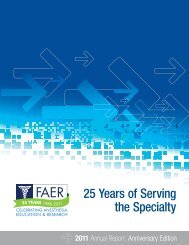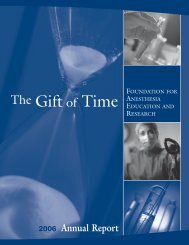2010 MSARF Symposium Participants - Foundation for Anesthesia ...
2010 MSARF Symposium Participants - Foundation for Anesthesia ...
2010 MSARF Symposium Participants - Foundation for Anesthesia ...
You also want an ePaper? Increase the reach of your titles
YUMPU automatically turns print PDFs into web optimized ePapers that Google loves.
overall mortality reduction was found compared to standard of care. The current study evaluates standard of care fluids<br />
versus Hextend plus standard of care <strong>for</strong> the resuscitation of trauma patients requiring immediate operative intervention<br />
within 4 hours of arrival. Patients were further divided into groups based on the mechanism of injury (penetrating or<br />
blunt), and data <strong>for</strong> the first 24 hours was collected. Outcomes were determined using hemodynamic, laboratory, and<br />
fluid data. Statistical analysis showed no significant demographic differences between the standard of care fluid and the<br />
Hextend group. Patients receiving Hextend therapy were in worse condition than the standard of care group on arrival to<br />
the hospital, with a higher initial heart rate, and lower baseline hematocrit. Despite this, the Hextend group required less<br />
fluids and blood products within the first 24 hours, with a greater urine output. This data supports the use of Hextend by<br />
the military <strong>for</strong> both blunt and penetrating trauma, but to better understand the efficacy, a randomized clinical trial is<br />
necessary.<br />
Student Name: Maleeha Mohiuddin<br />
Host Department: Northwestern University's Feinberg School of Medicine<br />
Primary Mentor Name: Paloma Toledo, MD, MPH<br />
Additional Mentors: Cynthia Wong, MD<br />
Title of Research Project: Racial/Ethnic Differences in Health Literacy and Use of Labor Neuraxial Analgesia<br />
Background: Neuraxial analgesia is the most effective method of relieving labor pain; however, a racial/ ethnic disparity<br />
exists in labor neuraxial analgesia use. We hypothesized that patients with low health literacy would be less likely to<br />
utilize neuraxial analgesia than patients with high health literacy.<br />
Methods: A survey was developed and tested <strong>for</strong> content validity. In-person interviews were conducted upon admission to<br />
the Labor and Delivery Unit, prior to a pre-anesthetic consultation. Data collected included demographic data, analgesic<br />
plans, source used <strong>for</strong> labor analgesia in<strong>for</strong>mation, knowledge of neuraxial analgesia, and health literacy (s-TOFLA). Data<br />
were analyzed using ?2 statistic. P





